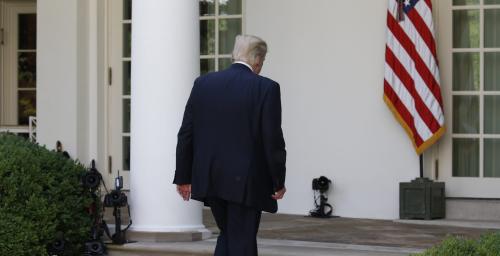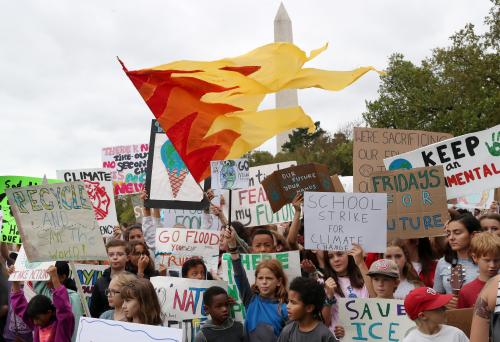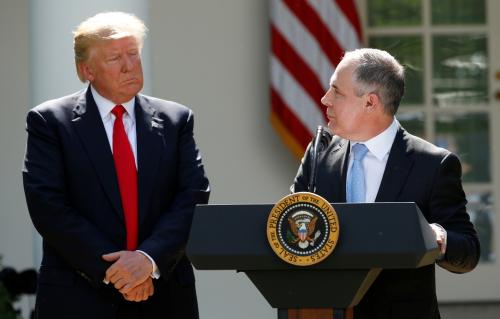Content from the Brookings Institution India Center is now archived. After seven years of an impactful partnership, as of September 11, 2020, Brookings India is now the Centre for Social and Economic Progress, an independent public policy institution based in India.
Content from the Brookings-Tsinghua Public Policy Center is now archived. Since October 1, 2020, Brookings has maintained a limited partnership with Tsinghua University School of Public Policy and Management that is intended to facilitate jointly organized dialogues, meetings, and/or events.
This post was originally published shortly before President Trump’s announcement on the U.S. withdrawal from the Paris climate accord, anticipating that outcome. It has since been updated to reflect the decision.
Today, President Donald Trump announced that he will withdraw the United States from the landmark Paris Agreement on climate change. It was adopted in 2015 by 195 nations, with 147 ratifying it—including the United States, which is the world’s second largest greenhouse gas emitter. Experts offer their analyses on what the decision could mean and what comes next.
William Galston: President Trump’s advisers may have suggested that withdrawing from the Paris climate accord would be a popular move. This is what they told him about the firing of FBI Director James Comey, and he seems to have believed it. This could become yet another self-inflicted wound, because vast majorities of Americans want to remain in the Paris accord, including many of Trump’s own supporters.
In a survey of registered voters taken just weeks after the 2016 election, 69 percent said that the United States should participate in the agreement. This figure included 86 percent of Democrats, 61 percent of Independents, and 51 percent of Republicans. By a margin of 40 to 34 percent, even a plurality of self-described conservative Republicans backed the agreement.
The administration has argued that the Paris Agreement is “unfair” because large polluting countries such as India and China are not required to do anything until 2030. The voters don’t buy this argument. Two-thirds of them—79 percent of Democrats, 56 percent of Independents, and 51 percent of Republicans—say that the United States should reduce its greenhouse gas emissions regardless of what other countries do.
This piece is excerpted from a longer blog post, read more: Paris Agreement enjoys more support than Donald Trump
Samantha Gross: The Trump administration’s decision to withdraw the United States from the Paris Agreement is a huge foreign policy blunder that will reverberate through our relationships with our allies. During the negotiation process, the United States pushed to make the agreement flexible to bring all countries on board and to keep them in the fold even if their situations and priorities changed. This flexibility means that our withdrawal would be completely unnecessary—the administration could have remained party to the agreement while still pursuing its policy goals.
Abdicating U.S. responsibility in climate change mitigation and the coming clean energy transition is likely to make other international negotiations more challenging, particularly with respect to trade. Our withdrawal also opens up a geopolitical space in climate leadership that may or may not be filled. The United States was a crucial force in bringing the Paris Agreement to fruition, especially in bringing China into the fold. Chinese President Xi Jinping expressed strong support for the Paris Agreement, and globalization in general, in his keynote address in Davos this January. Might China be looking to fill the leadership role that the United States is vacating?
Finally, the United States has been the major voice pushing for transparency and verification of compliance with nations’ stated goals, or Nationally Determined Contributions, throughout the process that led to the Paris Agreement. The measurement and reporting portions of the agreement are to be negotiated and put into place from now through 2020. U.S. leadership in this process will be sorely missed and implementation of the agreement may suffer in our absence.
Read more: Far from the White House, the energy industry remains focused on climate
Nate Hultman: The decision itself is a major error. The loss of American leadership hurts the ability of the international community to reach our scientifically grounded, global, long-term goals for reducing emissions to safer levels, and the president’s choice to lead the country back toward a 19th century energy economy will likely prove to be ill-conceived and bad for the American economy.
The decision also goes against the advice most of the country’s business elite. In his justification of the withdrawal, Trump cast Paris—a nonbinding structure to encourage international action on climate—as an unfair and heavily oppressive deal, and as the fount of phantasmagorical ills such as joblessness, economic stagnation, and trainloads of cash en route to a tricky cabal of conspirator states, including our allies. None of these claims is true or based on reputable analysis. To emphasize just two points, in contrast to Trump’s assertions, the structure of Paris means that nobody else dictates what the U.S.’s own goals should be, and China and India have indeed made significant commitments to emissions reduction and clean energy, which they are likely to meet or even exceed.
The piece is excerpted from a longer blog post, read more: The galvanized world response to Trump’s Paris Agreement decision
Mark Muro: My take is at once crestfallen and cautiously optimistic.
Without doubt Trump’s withdrawal of the United States from the Paris Agreement represents a tragic, rash error in judgment. In diplomatic and moral terms, the withdrawal represents a willful abdication of America’s leadership role in the world. And as a business mistake, the decision means the U.S. will miss out on some the $1.4 trillion global business opportunity that the global low-carbon economy represents. That the limited binding force of the agreement is nil makes the whole drama unnecessary and therefore even more distressing.
With that said, I believe that progress will continue. Internationally, other leaders—maybe India, maybe China—will assert themselves to fill the vacuum created by U.S. retreat.
Domestically, the problem isn’t so much the withdrawal from Paris as the more general problem of Trump’s efforts to actively dismantle U.S. climate policy at the federal level. And here, while there is much to worry about, including draconian cuts to the entire suite of clean energy innovation and deployment programs, there are real grounds for compensatory optimism. Ambitious state-level policies will continue to support the transition to a cleaner energy system. And for that matter, so will the increasingly impressive efforts of municipalities and businesses. Beyond that, there are signs that state and local actions may ratchet up as federalism allows states and cities to push back against federal irresponsibility and fill some gaps, even if their efforts are no substitute for a cohesive national stance.
To that extent, at least for the near term, the largest problem isn’t the withdrawal from the Paris Agreement. It’s President Trump and continued climate denialism in Washington.
Read more: Clean energy’s shifting reality: Venture capital recedes, but what’s next
Timmons Roberts: Why would the Trump administration take on this hail of criticism from home and abroad? Elsewhere, I’ve argued that Paris is not an “America second- or third-” agreement, as EPA Director Scott Pruitt has claimed. To the contrary, it is non-binding and has no enforcement mechanism if countries don’t meet their emissions targets. Trump has wavered on a number of other issues, but climate change was apparently one of the few where he wanted to stick to his campaign promise. Most explanations of this so far have been inadequate, and the issue needs serious investigation.
As with all Trump administration decisions, it is difficult to attribute causation, but the fact that the Paris Agreement is even being disputed, and the huge political capital expended by the White House to pull out, for me boils down to a two-decades-long campaign by the oil, coal, and gas industries. These actors started sowing the seeds of doubt about the overwhelming scientific consensus on climate change with a 1997/1998 effort in response to the Kyoto Protocol. Fossil fuel corporations have spent billions of dollars on the effort since then.
The case of Trump’s withdrawal from Paris provides an opportunity to understand the way industries are influencing politics and policy in our country, and what it means for our democracy. I would speculate that this past weekend’s letter from U.S. Senator Jim Inhofe (R-Okla.) along with 21 colleagues, and Ted Cruz’s—both of which provided cover for Trump’s decision—were both almost certainly written and orchestrated by fossil fuel companies, their industry organizations, or the PR firms they hire. As if to confirm this, in the past two weeks the Competitive Enterprise Institute ran 70 ads calling for the United States to leave Paris, over all major media outlets in D.C. The American Petroleum Institute has a $244 million a year budget to influence policy. There are many other fossil fuel firms and groups at work. These private voices creating distraction and delay on the existential problem of our time were heard by our leader, drowning out those of the majority of Americans who support American engagement with the rest of the world in solving this issue.
Read more: Trump dumps Paris: Now what?
Todd Stern: It succeeds where every effort before, for some 20 years, had come up short. It breaks new ground in numerous ways, articulating a long-range goal to drive global efforts, creating a bottom-up structure for ambitious national action, outlining a continually renewing set of commitments, bridging the differences between developed and developing countries, establishing a hybrid legal structure. And it did this all in the context of an agreement that is not just a statement of shared global principles, but a joint undertaking in which all countries are expected to do their part to shape the global economy in a productive and sustainable manner.
The idea that it is rational to support climate action but reject Paris does not, in fact, make sense. The idea that an agreement materially different from Paris could win the consensus support of countries everywhere is a fiction. Paris is an imperfect, but nonetheless remarkable agreement. It needs to be defended, supported and implemented.
The piece is excerpted from a longer blog post, read more: Why the Paris Agreement works
Vinod Thomas: The Trump administration’s decision to pull out of the agreement flies in the face of all this reality. (The only other two non-participants are Syria, who is in a civil war, and Nicaragua, who actually wanted a stronger agreement). The decision is against the U.S.’s own economic and geopolitical interests. It also shirks responsibility for the country’s share of the carbon footprint driving everyone’s fortunes.
Sri Lanka’s floods and India’s heatwaves are stark reminders of the needed priority for disaster resilience in national programs. But for these programs to have any chance of success, climate mitigation, especially by the biggest emitters, must take center stage.
The piece is excerpted from a longer blog post, read more: The climate crisis
Rahul Tongia, with a view from India: India’s current views on climate change have little to do with the United States, or any other country. In the past, issues of “who’s to blame” underpinned all negotiations. The current leadership is focused on growth and action, and, in fact, treats sustainability (especially growing renewable energy, or RE) as “an article of faith.” Whatever calculations India has on its NDCs remain independent of U.S. actions, and there are virtually no immediate or direct negative implications for India, and there are no global carbon prices to jump or fall.
Some may argue that India is no longer bound to undertake undue or heroic efforts, but with falling prices for clean tech, it’s possible that much of India’s actions are more market driven than a costly choice just to “do the right thing.” In fact, it’s possible that any reduction in U.S. clean tech deployment may make more technology and funding available for India. Global funding remains attractive for India, and almost all the RE India is deploying is by the private sector. India welcomes global capital for its scale and low interest rates.
India and the United States collaborate extensively on energy and clean energy, including through the U.S.-India Clean Energy Finance Task Force, which also draws in the private sector through complementary mechanisms. These efforts will likely continue as India represents an enormous (and now even more important) market for U.S. suppliers. The energy market is far more vibrant in India as overall demand is still growing by some 6-7 percent annually, and RE is targeted to grow by 25 percent annually, based on Indian plans announced even before the Paris Accord.
Is the United States leaving a vacuum? Numerous analysts talk of Chinese leadership, in which case India may not publicly embrace them, despite the fact that Chinese manufacturing fuels much of Indian solar panels (no solar cells are made in India, just assembled in to panels in India). India is also positioning itself as a sustainability leader, with Prime Minister Modi spearheading the International Solar Alliance (ISA) at Paris. Again, this effort benefits from U.S. support, but isn’t dependent on it.
Before we examine how India could react, we’d first need to ask why it would react. Given its actions and plans are domestically driven, it’s hard to make a case for “retaliation.” Leaving aside any theoretical but unlikely formal measures, it’s even unlikely India would join any global bottom-up efforts to counter “Make in America” with “Don’t Buy American.” Indian consumers don’t directly buy so many “Made in USA” products. What they do buy often no immediate alternative, especially in the IT world, with the “big five” of consumer tech—Google, Apple, Microsoft, Amazon, and Facebook—all being American. Notably, these companies are quite “green” in their energy purchases. Perhaps the world may evolve towards corporate differentiation on carbon, instead of national frameworks, which, like city and state efforts in the United States, might be a way forward to reducing global carbon emissions. Any consumer backlash would likely be more symbolic than impacting the bottom line, though it might hurt selected American companies more than others, especially where alternatives exist.
So does the U.S. withdrawal mean nothing for India? It may impact posturing, and even some amount of mindset, especially below the national leadership, but it will likely have less impact on on-ground activities. India may even double down on its efforts.
Read more: The future of electric vehicles in India
David Victor: Now that the United States is leaving the Paris Agreement, what’s next for international cooperation on climate change?
Some foreign policy analysts suggest that other countries will also head for the exit. I suspect the opposite will happen. For most countries, Paris does not require that they do much beyond what they were planning anyway. Despite the bold goal of stopping warming well below 2 degrees above pre-industrial levels—a goal that never could be met—Paris has always been about process. Countries make pledges for the efforts they will undertake and then periodic reviews check to see what is working and not. Over time, this process would make deeper cooperation easier. Chuck Sabel, a law professor at Columbia, and I have been calling this experimentalist governance of climate change. Countries, firms, and NGOs are committed to do something about global warming, but nobody really knows what will work and scale—policy experiments and learning are essential. And Paris was designed to achieve just that.
America’s exit isn’t good news for Paris, despite what some people have argued. America almost always plays a key role in building effective international institutions. Without America, leadership is diffused and harder to muster. The list of things left undone in Paris remains very long, and leadership is essential to turning the Paris framework into something truly effective. But the American exit is not fatal to the process. Indeed, the U.S., China, France, and others designed Paris so that it would be highly flexible—able to change in response to new realities, even the exit of the world’s most powerful nation. Even if the U.S. formally stayed inside the Paris agreement the lack of support for the process from the president on down has severely undermined the country’s ability to lead. Events like the recent G-7 meeting—which on climate and much else has now become the G6+1—will become more common.
This piece is excerpted from a longer blog post, read more: America exits the climate stage
Philip Wallach: A moment like this was, unfortunately, always a foreseeable possibility. Paris’s non-binding structure was chosen in large part to allow President Obama to sign without seeking Senate approval, which everyone understood he would be unlikely to get for any climate treaty given the abysmal relationship he had with Republicans during his second term. Climate activists in the United States largely wrote off the possibility of winning Republican support for any climate policy, deeming the task near-impossible. Instead they and the administration adopted a strategy that sought to circumvent the GOP, which they presumed could be treated as a manageable, if yippy, minority for years to come. They were wrong—and the Paris Agreement is now suffering the consequences.
The decision to withdraw will be endlessly analyzed, and many observers will inevitably focus on the interpersonal dramas of the Trump White House. But the truth is that this moment is mostly a function of party, rather than anything distinctive about Trump or his advisors. All of the leading Republican candidates for the presidency signaled their hostility to the Obama administration’s Paris pledge, and Republican legislators have largely maintained their opposition as their party has come into a position to follow through on its anti-Paris talk. Had Hillary Clinton won the presidency in 2016 but lost it in 2020, many of the same dynamics might have played out in 2021. If the United States is to achieve a more politically sustainable national climate policy, it will have to run through Republicans rather than around them.
This piece is excerpted from a longer blog post, read more: An America not in Paris
Rebecca Winthrop and Christina Kwauk: As the world reels from the news that the U.S. intends to pull out of the global Paris Agreement, there are still reasons to hope that our children can inherit a healthy planet. Paul Hawken, the well-known environmentalist, has a plan. His recent book is called Drawdown: The Most Comprehensive Plan Ever Proposed to Reverse Global Warming and it does just what the subtitle suggests. Under his coordination, researchers and scientists around the globe spent the last three years modeling what it would take to reduce carbon emissions or sequester carbon from the atmosphere. The book presents 100 proven interventions to immediately begin to stem the tide of climate change.
The good news is that the most effective intervention is not even in the Paris Agreement. Empowering girls and women through a combination of education and family planning is the number one thing the world can do to address climate change, ahead of switching to solar energy, wind energy, or a plant-rich diet. Investing in both girls’ education around the globe and enabling women access to contraception and reproductive healthcare would result in 120 gigatons of carbon reduced by 2050, a staggering amount compared to the 90 gigatons that could be reduced by better management of harmful chemical refrigerants like chlorofluorocarbons (CFCs).
This piece is excerpted from a longer blog post, read more: Concerned about the Paris Agreement? There’s still home through girls’ education




















Commentary
Trump’s Paris Agreement withdrawal: What it means and what comes next
June 1, 2017